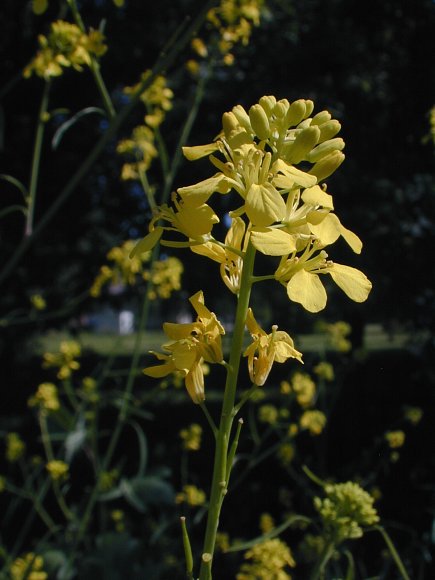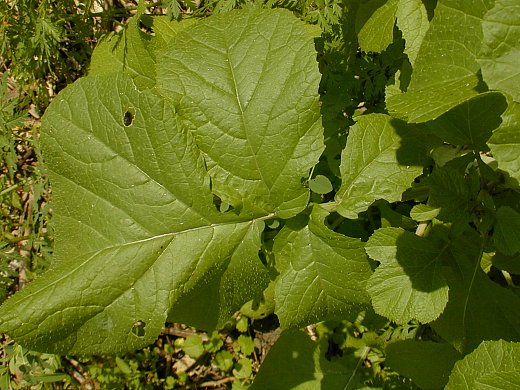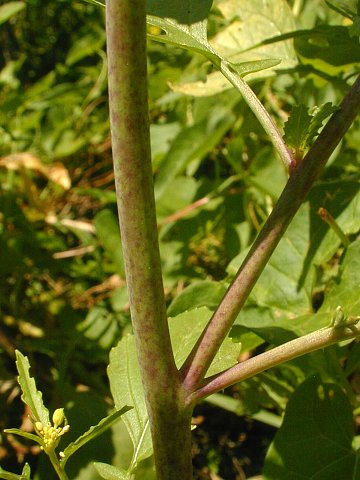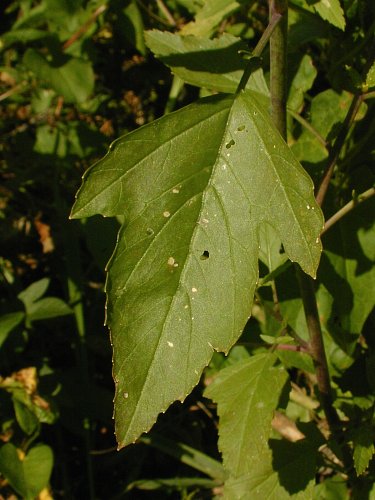Description: This plant is a summer annual that becomes 2-8' tall, branching occasionally. The stems are usually glabrous and glaucous; sometimes they have scattered stiff hairs toward the base. The alternate leaves are up to 10" long and 3" across, becoming smaller as they ascend the stems. The lower leaves are pinnately lobed and obovate in outline, tapering to a long and rather stout petiole. The terminal lobe is much larger than the lateral lobes. The upper surface of a lower leaf is often bristly with scattered hairs that are stiff, short, and white. The lower surface is usually glabrous, except for a few hairs along the central vein. The upper leaves are often lanceolate, broadly elliptic, or some other odd shape; they have 1-2 lobes or none.

The upper stems terminate in narrow racemes of yellow flowers; these racemes are ½–2' long when fully mature. Each flower is up to 1/3" (8 mm.) across, consisting of 4 yellow petals, 4 sepals, several stamens, and a pistil. The sepals are initially green, but become yellow while the flower blooms. The petals are well-rounded toward their tips. The blooming period occurs primarily during the summer and lasts about 1-2 months. A few plants may bloom during the fall. Each flower is replaced by a slender silique that becomes appressed against the stalk of the raceme as it matures. This silique is about 2/3" (17 mm.) long, tapering to a conical beak. The petiole of the silique (or flower) is about 1/3" (8 mm.) long. The seeds within this silique are dark brown or black. Both the seeds and the foliage have a pungent taste. The root system consists of a taproot. This plant spreads by reseeding itself.

Cultivation:
This
plant often occurs in full or partial sun, fertile soil, and mesic
conditions. On less fertile ground, it is smaller in size. During hot
sunny weather the leaves have a tendency to wilt, but they quickly
recover by nightfall. Sometimes this plant becomes lanky and flops
sideways.
Range & Habitat:
The non-native Black Mustard is a common plant in central and northern
Illinois, but
it is less common or absent in southern Illinois (see Distribution
Map). Habitats include weedy meadows, thickets, areas along
railroads and roadsides, fallow fields, vacant lots, and miscellaneous
waste places. Disturbed areas are preferred; Black Mustard doesn't
invade high quality natural areas to any significant degree. It is
native to Eurasia.

Faunal
Associations:
The nectar and pollen of the flowers attract primarily small bees and
flower flies; less common visitors include White butterflies and wasps.
The foliage is occasionally eaten by the caterpillars of various White
butterflies, including Pieris rapae (Cabbage White)
and Pontia protodice (Checkered White). The pungent
foliage is usually avoided by mammalian herbivores; it is somewhat
toxic to them.
Photographic Location:
Along a railroad in a partially shaded area in Urbana, Illinois.

Comments: If you see a lanky mustard plant with narrow stalks of yellow flowers that is over your head, there's a good chance that it's Black Mustard. The seeds of Black Mustard are often used in the table condiment, hot mustard. Among the many Brassica spp. and Synapis spp. (Mustards), Black Mustard can be identified by considering the following characteristics: 1) It is often quite tall, 2) the slender siliques are appressed together near the stalk of each raceme, 3) the siliques are less than ¾" long and they have distinct beaks, 4) the leaves narrowly clasp the stems, 5) the terminal lobes of the lower leaves are much larger than the lateral lobes, and 6) the lower leaves often have short stiff hairs and feel bristly to the touch. Other mustards are often lacking one or more of these features.